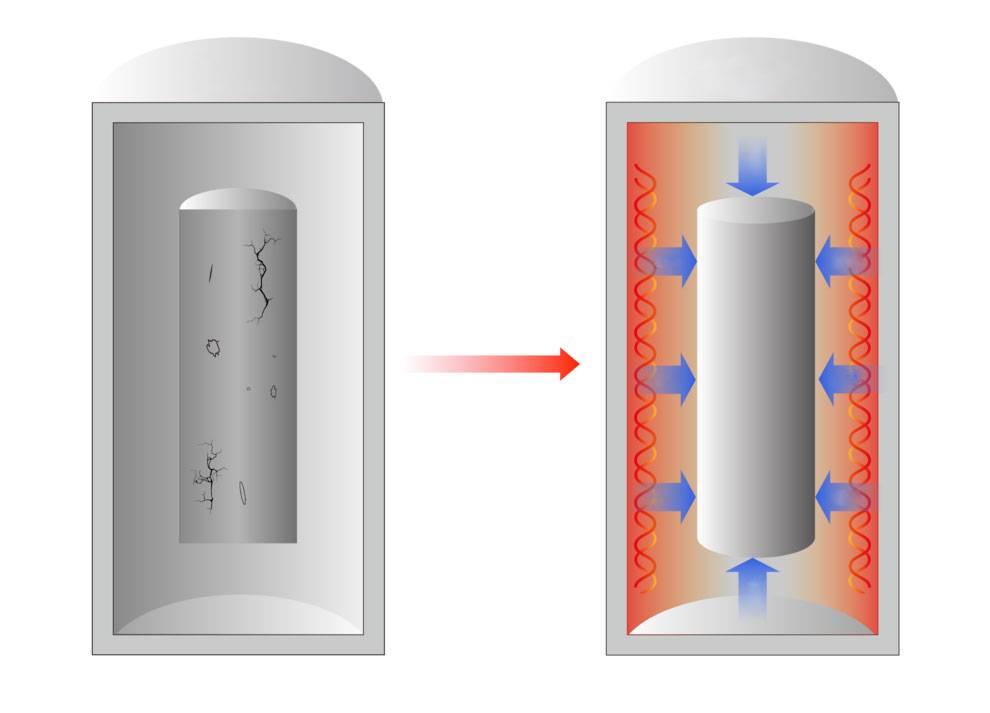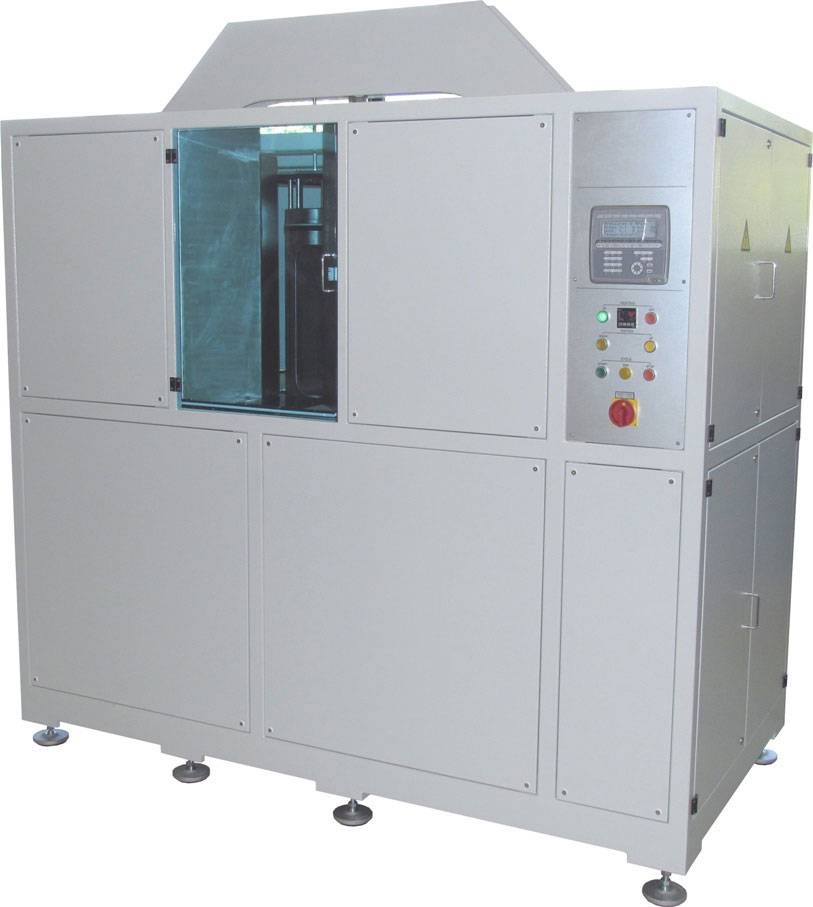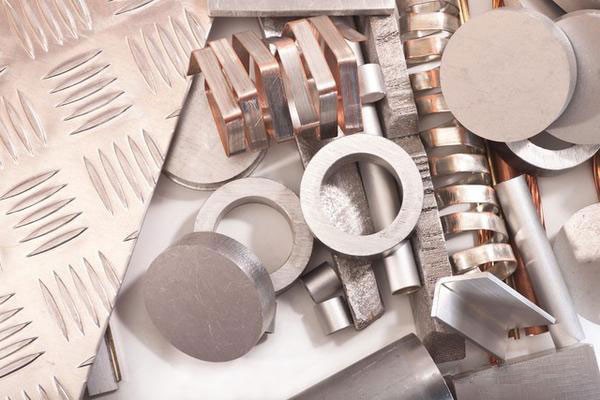Introduction to Hot Isostatic Pressing Technology
Overview and Significance
Hot isostatic pressing (HIP) is a sophisticated process technology that leverages high temperature and high pressure to subject metal or ceramic products to isotropic pressure. This uniform pressure facilitates the sintering and densification of these materials, a critical capability particularly in aerospace applications. The technology's importance in this sector stems from its unique ability to repair pores and significantly enhance the mechanical properties of cast high-temperature alloys.
In aerospace engineering, the integrity and performance of components are paramount. High-temperature alloys, such as those used in turbine blades, operate under extreme conditions that can lead to the formation of porosity and other defects. These imperfections can compromise the structural integrity and longevity of the components. HIP technology addresses this issue by applying uniform pressure and heat, which causes the material to undergo plastic deformation and diffusion creep. This process not only eliminates existing pores but also prevents the formation of new ones, thereby improving the overall density and mechanical strength of the alloy.
The significance of HIP in aerospace applications cannot be overstated. It is a key enabler in the production of high-performance, reliable components that can withstand the harsh environments encountered in aerospace operations. By enhancing the mechanical properties of these alloys, HIP contributes to the safety, efficiency, and longevity of aerospace systems, making it an indispensable technology in modern aerospace engineering.

Equipment Structure
The structure of hot isostatic pressing (HIP) equipment, plays a pivotal role in the application of this technology within the aerospace industry. HIP equipment is designed to subject materials to both high temperatures and high pressures, facilitating the isotropic densification of metals and ceramics. This process is indispensable for enhancing the mechanical properties and structural integrity of nickel-based casting high-temperature alloys, which are critical components in aerospace applications.
The equipment typically consists of several key components:
- Pressure Chamber: This is the core of the HIP system, where the materials are subjected to high pressure. The chamber is designed to withstand extreme conditions, ensuring uniform pressure distribution across the material.
- Heating Elements: These elements are responsible for maintaining the high temperatures required for the densification process. They are strategically placed to ensure even heat distribution.
- Gas Supply System: The system provides the inert gas, usually argon, which applies the isotropic pressure. The gas is carefully controlled to maintain the necessary pressure levels.
- Control Systems: Advanced control systems monitor and regulate the temperature, pressure, and time parameters to ensure the process is optimized for each specific material.
Understanding the structure and function of each component is essential for grasping how HIP technology enhances the properties of nickel-based alloys, making it a cornerstone in the aerospace sector.
Mechanisms and Principles
Densification Mechanism
The primary objective of hot isostatic pressing (HIP) in nickel-based casting high-temperature alloys is to eradicate voids and enhance material density. This process is pivotal in aerospace applications, where the integrity and performance of components are paramount. The densification mechanism is multifaceted, encompassing plastic flow, diffusion creep, and dislocation creep, all of which are propelled by atomic diffusion.

Plastic Flow and Diffusion Creep
Plastic flow occurs as the material undergoes deformation under high pressure and temperature, allowing voids to collapse and grains to rearrange. This rearrangement is facilitated by capillary action, where the liquid phase is drawn into pores, leading to a more favorable packing arrangement of grains. Additionally, diffusion creep plays a significant role, particularly in areas of high capillary pressure. Here, atoms preferentially dissolve and precipitate in regions of lower chemical potential, a process akin to grain boundary diffusion in solid-state sintering. This solution-precipitation mechanism not only fills voids but also enhances the overall densification of the material.
Dislocation Creep and Ostwald Ripening
Dislocation creep, driven by the movement of dislocations under stress, contributes to the densification process by enabling the material to accommodate high stresses without fracturing. This mechanism is particularly effective in high-temperature applications, where the mobility of dislocations is enhanced. Furthermore, Ostwald ripening occurs concurrently, where smaller particles dissolve and precipitate onto larger particles, leading to a more uniform particle distribution and further densification. This process is crucial in achieving the high densities required for superior mechanical properties in nickel-based alloys used in aerospace.
In summary, the densification mechanism in HIP involves a synergistic interplay of plastic flow, diffusion creep, dislocation creep, and Ostwald ripening, all driven by atomic diffusion. This comprehensive approach ensures the elimination of voids and the enhancement of density, thereby optimizing the performance and reliability of nickel-based casting high-temperature alloys in critical aerospace applications.
Parameter Formulation
Hot isostatic pressing (HIP) parameters, including temperature, pressure, and time, play a pivotal role in the optimization of alloy structures and the reduction of internal defects. These parameters are meticulously chosen to ensure that the HIP process achieves the desired densification and microstructural improvements. The temperature setting is particularly critical, as it influences the rate of atomic diffusion and the mobility of dislocations within the alloy. Typically, the temperature is set slightly below the alloy's melting point to facilitate plastic flow without causing melting or significant grain growth.
The pressure applied during HIP is another key factor, as it provides the isotropic force necessary for densification. Higher pressures can accelerate the closure of pores and voids within the material, but they must be balanced against the mechanical integrity of the alloy to prevent deformation or cracking. Time, the third critical parameter, ensures that the alloy remains under the combined influence of temperature and pressure for a sufficient duration to achieve the desired microstructural changes.
This treatment is often performed after solid solution treatment to enhance densification efficiency. By doing so, the alloy is pre-treated to create a more homogeneous distribution of elements, which in turn facilitates more effective densification during the HIP process. The synergy between these two treatments results in a material with superior mechanical properties and reduced internal flaws, making it ideal for demanding applications such as aerospace components.
| Parameter | Role in HIP Process |
|---|---|
| Temperature | Influences atomic diffusion and dislocation mobility |
| Pressure | Provides isotropic force for densification |
| Time | Ensures sufficient duration for microstructural changes |
In summary, the precise formulation of these parameters is essential for maximizing the benefits of hot isostatic pressing in nickel-based casting high-temperature alloys. Each parameter interacts with the others to create an environment where the alloy can undergo significant structural improvements, thereby enhancing its performance in critical applications.
Applications in Aerospace
Microstructure Repair
Hot isostatic pressing (HIP) has proven to be a highly effective method for repairing microstructural damage in nickel-based cast high-temperature alloys, particularly in components like turbine blades that undergo long-term service in demanding aerospace environments. The process involves subjecting the damaged alloy to high temperatures and pressures, which facilitate the restoration of critical properties such as creep resistance and mechanical strength.

One of the primary benefits of HIP in this context is its ability to restore the original microstructure of the alloy, which is often compromised due to prolonged exposure to high temperatures and stresses. This restoration is achieved through the densification of the material, where the high-pressure environment encourages the filling of voids and microcracks that have formed over time. This densification process is driven by mechanisms such as plastic flow, diffusion creep, and dislocation creep, all of which are facilitated by the elevated temperatures employed during HIP.
Moreover, HIP not only repairs the microstructural damage but also enhances the overall mechanical properties of the alloy. For instance, the process can significantly improve the tensile strength and ductility of the material, making it more resilient to future stresses and deformations. This dual benefit—microstructural repair and property enhancement—underscores the importance of HIP in maintaining the performance and longevity of nickel-based high-temperature alloys in aerospace applications.
Experimental Validation
The experimental validation of hot isostatic pressing (HIP) in repairing creep-damaged nickel-based single crystal high-temperature alloys has been convincingly demonstrated by Ruttert et al. Their research underscores the transformative impact of HIP on the mechanical properties of these critical materials, which are integral to aerospace applications. By subjecting the damaged alloys to HIP, the researchers observed a marked enhancement in the material's resilience and performance, effectively mitigating the detrimental effects of prolonged exposure to high temperatures and stress.
Key findings from their study reveal that HIP not only restores but also significantly improves the creep resistance of the alloys. This improvement is attributed to the uniform distribution of pressure and heat, which facilitates the elimination of microstructural defects such as voids and cracks. The process induces a densification effect, leading to a more homogeneous and stable microstructure. This, in turn, enhances the alloy's ability to withstand high-temperature environments without succumbing to creep deformation.
Moreover, the experimental results highlight the versatility of HIP in addressing various types of damage, making it a versatile tool in the arsenal of aerospace material repair technologies. The success of these experiments paves the way for broader application of HIP in the maintenance and refurbishment of high-temperature components, ensuring the longevity and reliability of aerospace systems.
Related Products
- Automatic Lab Cold Isostatic Press CIP Machine Cold Isostatic Pressing
- Lab-Scale Vacuum Induction Melting Furnace
- Vacuum Induction Melting Spinning System Arc Melting Furnace
- Vacuum Arc Induction Melting Furnace
- 600T Vacuum Induction Hot Press Furnace for Heat Treat and Sintering
Related Articles
- Exploring the Applications of Isostatic Pressing
- Electric Lab Cold Isostatic Press (CIP): Applications, Benefits, and Customization
- Cold Isostatic Pressing (CIP): A Proven Process for High-Performance Parts Manufacturing
- Application of Hot Isostatic Pressing Technology in Special Ceramic Preparation
- Additive Manufacturing for Isostatic Pressing: Bridging New Technology with Traditional Manufacturing



















